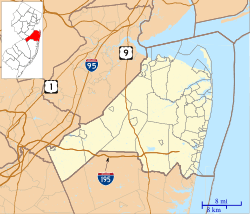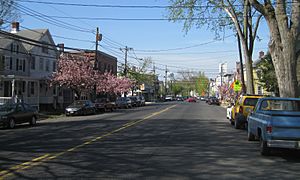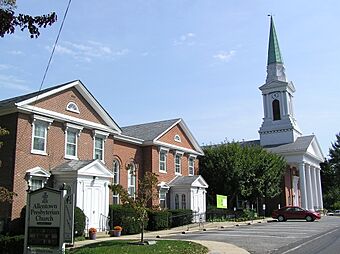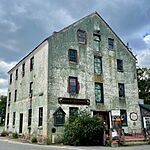Allentown, New Jersey facts for kids
Quick facts for kids
Allentown, New Jersey
|
|
|---|---|
|
Borough
|
|
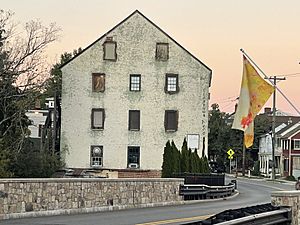
Allentown Mill in the center of town
|
|

Location of Allentown in Monmouth County highlighted in red (left). Inset map: Location of Monmouth County in New Jersey highlighted in orange (right).
|
|

Census Bureau map of Allentown, New Jersey
<mapframe text="Interactive map of Allentown, New Jersey" zoom="8" width="250" height="250"> { "type": "ExternalData", "service": "geoshape", "ids": "Q1085875" } </mapframe> |
|
| Country | |
| State | |
| County | Monmouth |
| Incorporated | January 29, 1889 |
| Named for | Nathan Allen or William Allen |
| Government | |
| • Type | Borough |
| • Body | Borough Council |
| Area | |
| • Total | 0.62 sq mi (1.61 km2) |
| • Land | 0.60 sq mi (1.54 km2) |
| • Water | 0.03 sq mi (0.06 km2) 4.03% |
| Area rank | 537th of 565 in state 45th of 53 in county |
| Elevation | 75 ft (23 m) |
| Population
(2020)
|
|
| • Total | 1,734 |
| • Estimate
(2023)
|
1,724 |
| • Rank | 498th of 565 in state 44th of 53 in county |
| • Density | 2,908.5/sq mi (1,123.0/km2) |
| • Density rank | 223rd of 565 in state 26th of 53 in county |
| Time zone | UTC−05:00 (Eastern (EST)) |
| • Summer (DST) | UTC−04:00 (Eastern (EDT)) |
| ZIP Code |
08501
|
| Area codes | 609 Exchanges: 259, 752, 758 |
| FIPS code | 3402500760 |
| GNIS feature ID | 0885137 |
| Website | |
Allentown is a borough located in western Monmouth County, in the U.S. state of New Jersey, bordering adjacent Mercer County. As of the 2020 United States census, the borough's population was 1,734, a decrease of 94 (−5.1%) from the 2010 census count of 1,828, which in turn reflected a decline of 54 (−2.9%) from the 1,882 counted in the 2000 census. The borough is nestled within central New Jersey, and is roughly equidistant between New York City and Philadelphia.
Contents
History
Allentown was incorporated as a borough by an act of the New Jersey Legislature on January 29, 1889, from portions of Upper Freehold Township, based on the results of a referendum held that day. The borough was named for settler Robert Burnet's son-in-law, Nathan Allen or for William Allen, who served as Chief Justice of the Province of Pennsylvania.
Geography
According to the U.S. Census Bureau, the borough had a total area of 0.62 square miles (1.61 km2), including 0.60 square miles (1.54 km2) of land and 0.03 square miles (0.06 km2) of water (4.03%).
Allentown borders the municipalities of Upper Freehold Township in Monmouth County and Robbinsville Township in Mercer County.
Economy
Allentown's shopping district has antique and specialty shops, as well as restaurants. Many historic homes and historic buildings are located in the borough. The Horse Park of New Jersey is a park located near the borough but does have an Allentown mailing address. Heritage Park is located within the borough near the shopping district.
The borough received the 'Village Center' designation in 2002, which will allow the borough to receive additional state aid aimed at preserving historic and natural resource sites that are at risk.
For larger scaled shopping, Freehold Raceway Mall in nearby Freehold, Quaker Bridge Mall in nearby Lawrence, and Princeton Market Fair in nearby Princeton, are a short distance away.
Demographics
| Historical population | |||
|---|---|---|---|
| Census | Pop. | %± | |
| 1900 | 695 | — | |
| 1910 | 634 | −8.8% | |
| 1920 | 634 | 0.0% | |
| 1930 | 706 | 11.4% | |
| 1940 | 766 | 8.5% | |
| 1950 | 931 | 21.5% | |
| 1960 | 1,393 | 49.6% | |
| 1970 | 1,603 | 15.1% | |
| 1980 | 1,962 | 22.4% | |
| 1990 | 1,828 | −6.8% | |
| 2000 | 1,882 | 3.0% | |
| 2010 | 1,828 | −2.9% | |
| 2020 | 1,734 | −5.1% | |
| 2023 (est.) | 1,724 | −5.7% | |
| Population sources: 1900–1920 1900–1910 1910–1930 1940–2000 2010 2020 |
|||
2010 census
The 2010 United States census counted 1,828 people, 704 households, and 499 families in the borough. The population density was 3,023.9 per square mile (1,167.5/km2). There were 735 housing units at an average density of 1,215.8 per square mile (469.4/km2). The racial makeup was 90.97% (1,663) White, 4.43% (81) Black or African American, 0.11% (2) Native American, 1.53% (28) Asian, 0.00% (0) Pacific Islander, 0.88% (16) from other races, and 2.08% (38) from two or more races. Hispanic or Latino of any race were 3.56% (65) of the population.
Of the 704 households, 33.7% had children under the age of 18; 54.8% were married couples living together; 12.1% had a female householder with no husband present and 29.1% were non-families. Of all households, 22.7% were made up of individuals and 7.8% had someone living alone who was 65 years of age or older. The average household size was 2.60 and the average family size was 3.11.
24.8% of the population were under the age of 18, 7.3% from 18 to 24, 22.2% from 25 to 44, 34.4% from 45 to 64, and 11.4% who were 65 years of age or older. The median age was 42.4 years. For every 100 females, the population had 90.8 males. For every 100 females ages 18 and older there were 89.7 males.
The Census Bureau's 2006–2010 American Community Survey showed that (in 2010 inflation-adjusted dollars) median household income was $93,250 (with a margin of error of +/− $15,183) and the median family income was $101,875 (+/− $5,413). Males had a median income of $75,125 (+/− $13,989) versus $55,119 (+/− $7,348) for females. The per capita income for the borough was $36,970 (+/− $2,599). About 1.8% of families and 1.3% of the population were below the poverty line, including 0.8% of those under age 18 and 2.5% of those age 65 or over.
Education
Students in public school for kindergarten through twelfth grade attend the schools of the Upper Freehold Regional School District, together with students from Upper Freehold Township. Millstone Township sends students to the district's high school as part of a sending/receiving relationship with the Millstone Township Schools. As of the 2021–22 school year, the district, comprised of three schools, had an enrollment of 2,124 students and 176.2 classroom teachers (on an FTE basis), for a student–teacher ratio of 12.1:1. Schools in the district (with 2021–22 enrollment data from the National Center for Education Statistics) are Newell Elementary School with 516 students in grades PreK-4, Stone Bridge Middle School with 460 students in grades 5-8 and Allentown High School with 1,131 students in grades 9-12. The operations of the district are overseen by a nine-member board of education, with the board's trustees elected directly by voters to serve three-year terms of office on a staggered basis, with three seats up for election each year. The nine seats are allocated to the two constituent municipalities based on population, with four assigned to Allentown.
Historic district
The Allentown Historic District is a 17-acre (6.9 ha) historic district encompassing the community along North and South Main streets, Church, Pearl and Hamilton streets, Lakeview Drive and Yardville Road. It was added to the National Register of Historic Places on June 14, 1982, for its significance in architecture, commerce, education, industry, invention, religion, and transportation. The district includes 219 contributing buildings, including the Allentown Mill, which was added individually to the NRHP in 1978.
The Allentown Presbyterian Church was built in 1837, expanded in 1858, and features Greek Revival architecture. The Georgian-style John Imlay House, built c. 1790, was documented by the Historic American Buildings Survey in 1936. The Ephraim Robbins House now serves as the Borough Hall. The former First Baptist Church is now used by the Allentown Public Library Association.
Transportation
As of May 2010[update], the borough had a total of 6.84 miles (11.01 km) of roadways, of which 4.55 miles (7.32 km) were maintained by the municipality and 2.29 miles (3.69 km) by Monmouth County.
The only major roads that pass through are CR 524, CR 526 and CR 539.
Limited access roads that are accessible just outside the borough include Interstate 195 and the New Jersey Turnpike (Interstate 95).
Allentown is about one hour southwest of Manhattan via the Turnpike and about 50 minutes northeast of Philadelphia. Both Princeton and Trenton are easily accessible from Allentown via I-195.
Notable people
People who were born in, residents of, or otherwise closely associated with Allentown include:
- Doc Imlay (1889–1948), Major League Baseball pitcher who played for the Philadelphia Phillies in nine games during the 1913 Philadelphia Phillies season
- William Longstreet (1759–1814), inventor who designed an improved cotton gin, a portable sawmill, and builder of a small steamboat that worked on the Savannah River
- Tom McCarthy (born 1968), TV announcer for the Philadelphia Phillies
- Linda K. Meirs (1884–1972), American Red Cross and Army nurse during World War I who was one of the first six American recipients of the Florence Nightingale Medal
- George Middleton (1800–1888), represented New Jersey's 2nd congressional district from 1863 to 1865
- John B. Montgomery (1794–1872), United States Navy officer during the American Civil War, who later commanded the Pacific Squadron
- William A. Newell (1817–1901), physician and politician
- George R. Robbins (1814–1875), politician who represented New Jersey's 2nd congressional district in the United States House of Representatives from 1855 to 1859
- Warren Lincoln Rogers (1877–1938), bishop of the Episcopal Diocese of Ohio from 1930 to 1938
- Billy Schuler (born 1990), soccer player for the Carolina RailHawks in the North American Soccer League
See also
 In Spanish: Allentown (Nueva Jersey) para niños
In Spanish: Allentown (Nueva Jersey) para niños


